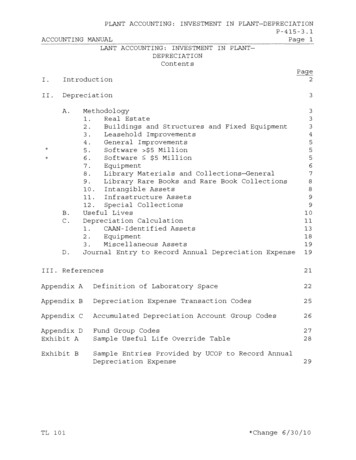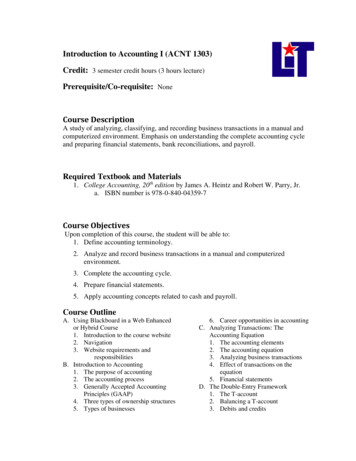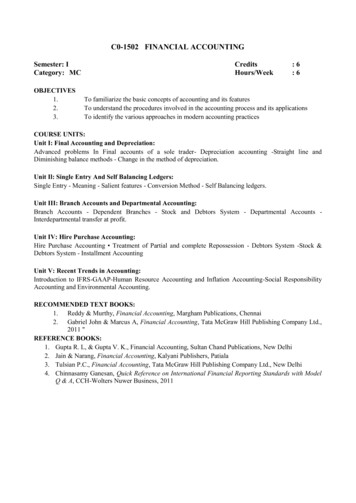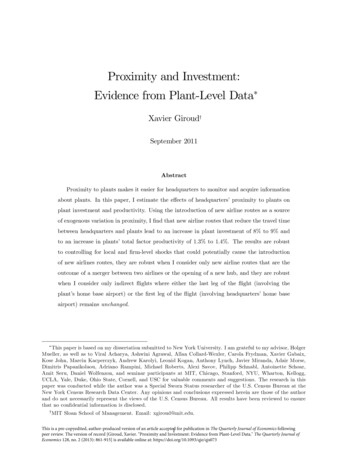
Transcription
PLANT ACCOUNTING: INVESTMENT IN PLANT-DEPRECIATIONP-415-3.lPage 1ACCOUNTING MANUALLANT ACCOUNTING: INVESTMENT IN reciationA.**B.C.D.3Methodology1.Real EstateBuildings and Structures and Fixed Equipment2.Leasehold Improvements3.General Improvements4.Software 5 Million5.Software 5 Million6.7.Equipment8.Library Materials and Collections-General9.Library Rare Books and Rare Book Collections10.Intangible Assets11.Infrastructure Assets12.Special CollectionsUseful LivesDepreciation Calculation1.CAAN-Identified Assets2.Equipment3.Miscellaneous AssetsJournal Entry to Record Annual Depreciation ExpenseIII. References333455567889910111318191921Appendix ADefinition of Laboratory Space22Appendix BDepreciation Expense Transaction Codes25Appendix CAccumulated Depreciation Account Group Codes26Appendix DExhibit AFund Group CodesSample Useful Life Override Table27Exhibit BSample Entries Provided by UCOP to Record AnnualDepreciation ExpenseTL 1012829*Change 6/30/10
PLANT ACCOUNTING: INVESTMENT IN PLANT-DEPRECIATIONP-415-3.1ACCOUNTING MANUALPage 2PLANT ACCOUNTING: INVESTMENT IN PLANTDEPRECIATIONI.INTRODUCTIONHistorically, the University did not report depreciation inits University-wide audited financial statements; however,University medical centers reported depreciation on theirindividual financial statements.In December 1999, the Government Accounting Standards Board(GASB) issued Statement No. 35, Basic Financial Statementsand Management's Discussion and Analysis-for PublicColleges and Universities.The Statement effectivelyextended the governmental reporting model required by GASBStatement No. 34, Basic Financial Statements-andManagement's Discussion and Analysis-for State and LocalGovernments, to include public colleges and universities.Depreciation of capital assets is required by these rules.The University was required to comply with the depreciationreporting requirements for the fiscal year endedJune 30, 2002.In addition to the depreciation reporting requirementsprescribed in GASB Statement No. 34 and 35, the Universitymust consider the requirements of Generally AcceptedAccounting Principles, Generally Accepted AuditingStandards, Medicare costing rules, OMB Circular A-21, andthe Internal Revenue Code.This chapter outlines the procedures required fordepreciating the University's assets.Refer to chapter P415-3 for the procedures related to capitalizing theUniversity's assets and eliminating capital expendituresfrom Current Funds, and chapter P-415-3.2 for theprocedures related to disposals, write-offs and gains andlosses (this chapter is under development) .6/30/04TL 92
PLANT ACCOUNTING: INVESTMENT IN PLANT-DEPRECIATIONP-415-3.lPage 3ACCOUNTING MANUALII. DEPRECIATIONA.METHODOLOGYThe University will use the straight-line method ofcalculating depreciation for financial reportingpurposes.1.Real EstateReal Estate will be capitalized, but notdepreciated.2.Buildings and Structures and Fixed EquipmentBuildings, structures (including permanentlyanchored trailers or modular buildings) and fixedequipment are treated as the same class of assetsfor depreciation purposes. Amounts separatelyidentified as Fixed Equipment will be summarizedby capital asset account number (CAAN) withamounts identified as Buildings & Structures.Each building capitalization (including additionsand renovations to existing buildings) will betracked and depreciated separately with its ownuseful life determined in accordance with one ofthe methodologies described below. Depreciationwill be accumulated until the asset is fullydepreciated.Campuses may elect to survey an individualbuilding/structure or a specific year'sincremental capitalization in order to determinethe useful life for each surveyed building orincrement.Each year, UCOP will collect overrideuseful life data for surveyed buildings fromcampuses (see Exhibit A for a sample worksheetprovided by UCOP to campuses) .If the useful life of a new building isdetermined by a survey, that useful life will beused to depreciate the initial capitalizationand all future increments for the buildingunless later increments by year are surveyed.TL 926/30/04
PLANT ACCOUNTING: INVESTMENT IN PLANT-DEPRECIATIONP-415-3.lACCOUNTING MANUALPage 4I.DEPRECIATIONA.METHODOLOGY2.Buildings and Structures and Fixed Equipment(Cont'd.)If increments are surveyed, the life determinedfor the increment will be used for calculatingdepreciation on that increment only. All futureincrements for the same building must besurveyed."Laboratory" buildings are defined as: Buildings where at least 25 percent of thetotal assignable square feet (ASF) of thebuilding is dedicated to laboratory space, or Buildings with at least 7,500 ASF of laboratoryspace.Laboratory space is defined using Room Use Codes,Program Codes and, where necessary, DepartmentCodes as they appear in the annual Facilitiesfile (EFA70). Appendix A provides a list of thecodes that are used to identify laboratory space.Campuses may request that additions or deletionsbe made to the Program Codes or Department Codesused to define laboratory space by submittingrequests to UCOP-Costing Policy Analysis at thetime a building or increment is capitalized(refer to chapter P-415-3).Laboratory buildings that have not been surveyedwill be depreciated using a 26 year useful life.Buildings not qualifying as laboratory buildingsthat have not been surveyed will be depreciatedusing a 33 year useful life.3.Leasehold ImprovementsThe University will depreciate leaseholdimprovements using the applicable default usefullife for the building (26 years for laboratorybuildings or 33 years for other buildings) unlessa useful life override is provided by the campus.6/30/04TL 92
PLANT ACCOUNTING: INVESTMENT IN PLANT-DEPRECIATIONP-415-3.1ACCOUNTING MANUALPage 5The useful life override for leaseholdimprovements should normally be the expectedremaining years on the lease agreement.Theremaining years for the lease agreement should beprovided annually when the campus provides usefullife override data to UCOP.4.General ImprovementsEach general improvement capitalization will betracked and depreciated separately with a 15year useful life.*5)Software 5 MillionThe University will depreciate the annualincremental additions to these software costsfor a period of seven years beginning in theyear after the costs are capitalized.Depreciation will be calculated from theaggregated change in General Ledger balances atJune 30. After seven years, the costs, alongwith the accumulated depreciation, will bewritten off on the local ledger (chapter P-4153. 2 Disposals, Write-Offs and Gains & Losses isunder development) .*6)Software 5 MillionThe University will depreciate incrementaladditions to software costs for a period ofthree years beginning in the year after thecosts are capitalized. Annual increments fordepreciation will be calculated from theaggregated change in the General Ledger balancesat June 30. After three years, the costs, alongwith the accumulated depreciation, will bewritten off on the local ledger (chapter P-4153. 2 Disposals, Write-Offs and Gains & Losses isunder development).TL 101*Change 6/30/10
PLANT ACCOUNTING: INVESTMENT IN PLANT-DEPRECIATIONP-415-3.1Page 6ACCOUNTING MANUALII.DEPRECIATIONA.METHODOLOGY (Cont'd.)7.EquipmentThe University will capitalize and depreciateUniversity-owned capital equipment, as well asnon-University-owned equipment purchased withfederal funds or on loan from a federal agency(with the exception of equipment classificationcode (calcode) H50XX-Works of Art, Antiques andSpecial Collections which is capitalized, but notdepreciated) .Useful lives will be established at the time ofacquisition and will be based on theclassification code assigned to the equipment andthe University-wide useful life table (availableat http://eulid.ucop.edu/).The useful lifeassigned to an item of equipment will not beadjusted, regardless of additions or deletions.However, equipment with additions will beeffectively depreciated over a period of timelonger than its assigned useful life.The following provides an illustration of theapproach to equipment depreciation:6/30/04 An item of equipment is purchased in October2001 for 50,000 and has a five year usefullife.The annual depreciation expense is 10,000. In August 2004, a 20,000 addition is madeto the equipment. Although the useful life for the equipmentis five years, the equipment will be fullydepreciated in six years when theaccumulated depreciation equals theacquisition value.TL 92
PLANT ACCOUNTING: INVESTMENT IN PLANT-DEPRECIATIONP-415-3.1Page 7ACCOUNTING MANUALFYAcquisitionValueUsefulLifeUC ReportedDepreciationExpenseUC ReportedAccumulatedDepreciation2002 50,0005 10,000 0770,000512,00070,000Non-Inventorial Equipment at Medical CentersMedical centers may capitalize items that arenot considered inventorial according to theUniversity's definition of equipment.The totalannual aggregate value of capitalized noninventorial items will be recorded in equipmentinventory code F9999 and depreciated over acomposite life of 15 years (see chapter P-415-2,Plant Accounting: Costing and ReconcilingInventorial Equipment Acquisitions). When thenon-inventorial equipment has either beendisposed or fully depreciated (whichever comesfirst), the costs, along with the accumulateddepreciation, will be written-off by thehospital (chapter P-415.3.2, Disposals, WriteOffs and Gains & Losses is under development).This will require communication with the campusequipment management and plant accountant.8.Library Materials and Collections-GeneralThe University will depreciate general campuslibrary materials and collections using a 15year useful life.Campus libraries willcontinue to provide local accounting off iceswith the expenditures to be capitalized inaccordance with guidelines set forth the chapterL-316-11, Libraries and Collections:Capitalization.9.Library Rare Books and Rare Book CollectionsRare or museum-type books and other rare librarymaterials will be capitalized, but not depreciated.TL 926/30/04
PLANT ACCOUNTING: INVESTMENT IN PLANT-DEPRECIATIONP-415-3.1Page 8ACCOUNTING MANUALII.A.10.DEPRECIATIONMETHODOLOGY (Cont'd.)Intangible AssetsThe University will depreciate intangible assets. Theuseful life for intangible assets will be determinedon a case-by-case basis and reported to UCOP as auseful life override (see Exhibit A for a sampleworksheet provided by UCOP to campuses) . Unlessotherwise specified by the campus in the overrideuseful life file, 40 years will be the default lifefor all intangible assets.The following should be guidelines for determiningthe override useful life reported to UCOP: 6/30/04 Goodwill may be amortized over periods up to 40years, depending on the underlying economicsubstance. Covenants not to compete will be amortized overthe term of the agreement. Purchased patents will be amortized over thelesser of the remaining life of the patent or 17years, unless it is demonstrated that it shouldbe accelerated.Gifts of intellectual property will be amortized aminimum of 8 years (see chapter G-327, Gifts:Financial Reporting of Gifts of Tangible andIntangible Property) .TL 92
PLANT ACCOUNTING: INVESTMENT IN PLANT-DEPRECIATIONP-415-3.1ACCOUNTING MANUALPage 9When the net book value of the asset reaches zero,the costs, along with the accumulated depreciation,will be written off on the local ledger (chapter P415-3. 2 Disposals, Write-Offs and Gains & Losses isunder development) .11.Infrastructure AssetsEach infrastructure assets capitalization will betracked and depreciated separately with a 25 yearuseful life.12.Special CollectionsSpecial collections will be capitalized, but notdepreciated.TL 926/30/04
PLANT ACCOUNTING: INVESTMENT IN PLANT-DEPRECIATIONP-415-3.1ACCOUNTING MANUALPage 10II.DEPRECIATIONB.USEFUL LIVESThe following table summarizes the useful lives by assetcategory.Asset Useful Life SummaryAsset CategoryUseful LifeBuildings & Structures and FixedEquipment** Surveyed buildings/structuresBased on survey andprovided to UCOP as auseful life override Non-surveyed "laboratory"buildings/structures26 years Non-surveyed "other"buildings/structures33 yearsLeasehold Improvements26 or 33 years unlessuseful life override isprovided by campusGeneral Improvements15 yearsEquipment2-20 years (refer toUniversity Useful LifeTable for equipment 1 )Non-Inventorial Equipment at MedicalCenters15 yearsLibrary Materials and Collections(General)15 yearsSoftware Software and Software Projectss 5 Million Software projects 5million3 years7 yearsIntangible Assets40 years unless usefullife override is providedby campusInfrastructure Assets25 yearsThe University Useful Life table for equipment is available athttp://eulid.ucop.edu/*Change 6/30/10TL 101
PLANT ACCOUNTING: INVESTMENT IN PLANT-DEPRECIATIONP-415-3.1ACCOUNTING MANUALPage 11Useful Life OverrideEach year, campuses will provide UCOP with the overridevalues for the useful life for selected asset types (seeExhibit A for a sample worksheet provided by UCOP tocampuses) . Override values may be submitted for thefollowing selected asset types:C. Buildings and structures that were surveyed anddetermined to have a different useful life than thedefault values of 26 years for laboratory buildingsand 33 years for other buildings. Any building capitalized at December 31 that was notincluded in the annual Facilities File (EFA70) shouldbe included with the appropriate useful life. Leasehold improvements to buildings and structuresdetermined to have a different life than the defaultvalues of 26 years for laboratory buildings or 33years for other buildings. Intangible assets that have a shorter life than thedefault value of 40 years.DEPRECIATION CALCULATIONThe depreciation calculations for the University will beperformed by UCOP-Financial Management, using dataprovided by the campuses.Summarized depreciation datawill be returned to the campuses to be recorded in thelocal General Ledger systems.The following chart summarizes the types of assets to bedepreciated and the corresponding campus interface filethat will be used as the source of data. Moreinformation about the corporate interface files isavailable at http://www.ucop.edu/irc/appsys.html.TL 926/30/04
PLANT ACCOUNTING: INVESTMENT IN PLANT-DEPRECIATIONP-415-3.1Page 12ACCOUNTING MANUALIV.DEPRECIATIONC.DEPRECIATION CALCULATION (Cont'd.)Source of Campus Data for DepreciationAsset CategoryCAAN-Identified Assets Buildings & Structures(including Fixed Equipmentand Leasehold Improvements) General Improvements Intangible Assets Infrastructure Assets**Corporate Interface File CFS Asset File (CFSAST) asof December 31 due theeighth working day ofFebruary Facilities Building (EFA71)and Room (EFA70)Files 2 , duethe tenth working day ofDecemberSoftware 5 MillionSoftware 5 MillionLibrary Materials andCollections-General CFS Balances File (CFSBAL)as of June 30 Final due inearly August in accordancewith the annual closingscheduleEquipment EFAlOO and EFA200 3 Files asof December 31 due theeighth working day ofFebruary2Facilitie room and building files (EFA70 and EFA71) are used to determine the"laboratory" and "other" buildings designation necessary for the annualdepreciation calculation.3Equipment-Facilities Conversion file (EFA200) is also submitted with theEquipment Inventory file (EFAlOO) . The EFA200 is a cross reference file thatcampuses create to link equipment departments to facilities programs.*Change 6/30/10TL 101
PLANT ACCOUNTING: INVESTMENT IN PLANT-DEPRECIATIONP-415-3.1Page 13ACCOUNTING MANUAL1.CAAN-Identified AssetsThe annual CFSAST file submission will provide UCOPwith the campus data for all CAAN-identified assets,including Buildings and Structures (including FixedEquipment and Leasehold Improvements), GeneralImprovements, Intangible Assets, and InfrastructureAssets. File specifications are available athttp://www.ucop.edu/irc/campus specs/cfs/.UCOP will use the CFSAST files to update the CAANidentif ied asset depreciation table in order tocalculate the current fiscal year depreciationexpense and the accumulated depreciation associatedwith the disposal of CAAN-identified capital assets.Each year, UCOP will provide campuses with thedepreciation entries to be recorded in campus GeneralLedgers by June 30.a.CFSAST-Record TypesThe CFSAST file contains two record types: Record Type 12 contains year-end balances foreach asset by account and fund. Negativebalances should not appear in the CFSAST Type12 Records and there should be no more thanone Type 12 record for a given combination oflocationl-sublocation-account-fund-CAAN.Note: TL 92Location 1 indicates the majorlocation or physical campus, e.g.,Berkeley 01, San Francisco 02.Sublocation indicates whether theaccount is:local campus (notincluding local medical center) l;systemwide or UCOP 2; or localmedical center 3.Record Type 13 contains transactions for thecurrent fiscal year activity for each asset byaccount and fund.6/30/04
PLANT ACCOUNTING: INVESTMENT IN PLANT-DEPRECIATIONP-415-3.1Page 14ACCOUNTING MANUALIV.DEPRECIATIONC.DEPRECIATION CALCULATION1.CAAN-Identified Assets (Cont'd.)The Record Type 13 transaction records provide nearlyall of the data required for updating the CAANidentif ied asset depreciation table. Assetdescriptions are provided from the Record Type 12balance records.b.CFSAST-Action Code ValuesThe Record Type 13 submission includes a twodigit data element titled, "Action Code"(separate and distinct from "Transaction Codes")which is used to identify types of activity. Theaction codes are: 10-New increment/additionTransactions using action code lX representnew capitalizations and are normally positiveamounts (i.e., debit entries to increase assetvalue). A credit transaction (i.e., anegative amount) is acceptable only to correcta debit transaction made within the sameperiod for the same asset, provided that thenet effect for a given locationl-sublocationasset type-fund source-CAAN is either a debitor zero.If the net effect is a credit (e.g.,posting a correction to an over-capitalizationfrom the prior period) , then action code 2Xmust be used for the credit transaction.(Ref er also to the CorrectingOvercapitalizations section below.) 2 0-Di sposalTransactions using action code 2X representreductions in capitalized value and arenormally negative amounts (i.e., creditentries to decrease asset value) . A debittransaction (i.e., a positive amount) isacceptable only to correct a6/30/04TL 92
PLANT ACCOUNTING: INVESTMENT IN PLANT-DEPRECIATIONP-415-3.1Page 15ACCOUNTING MANUALcredit transaction made within the same periodfor the same asset, provided that the neteffect for a given locationl-sublocation-assettype-fund source-CAAN is either a credit orzero. If the net effect is a debit, thenaction code lX must be used for the debittransaction. (Refer also to the CorrectingOvercapitalizations section below.) 30-Intercampus transfer (Sending campus)Transactions using action code 30 representtransferring assets to another campus andmust be negative amounts. 40-Intercampus transfer (Receiving campus)Transactions using action code 40 representtransferring assets from another campus andmust be positive amounts. 50-Transfer/adjustment within a campus(i.e., changes to a sub-location, fundingsource, asset type, asset sub-type and/orCAAN)Transactions using action code 50 representmovements of capitalized values within onecampus and are reported as positive amounts inthe Record Type 13 record.The action code 50record provides the amount to be deducted fromthe incorrect sub-location, funding source,asset type, asset sub-type and/or CAAN, andthe amount to be added to the correct subloca t ion, funding source, asset type, assetsub-type and/or CAAN.(Refer also to theCorrecting Overcapitalizations section below.)The above action code values provide the levelof detail required for capturing dat fordepreciation purposes.Campuses may wish torecord at a lower level of detail in theirlocal systems and transmit this data toTL 926/30/04
PLANT ACCOUNTING: INVESTMENT IN PLANT-DEPRECIATIONP-415-3.1Page 16IV.ACCOUNTING MANUALDEPRECIATIONC.DEPRECIATION CALCULATION1.CAAN-Identified Assets (Cont'd.)UCOP. However, all increments will beaggregated to the level of the first positionof the action code (e.g., action code 11 willbe read and retained by the depreciation systemas an action code 10). The optional actioncode values are for new increments or disposalsonly: c.New Increments (will be read and retained asaction code 10 in the depreciation system) :11Financed from Plant Funds12Financed from Current Funds13Gifts14Adjustments and otherDisposals (will be read and retained asaction code 20 in the depreciation system)21Sale of the asset22Demolition of asset23OtherCFSAST-Correcting CAAN OvercapitalizationsOvercapitalizations may be corrected in theCFSAST file using the following guidance: Corrections made in the current reportingperiod (i.e., both the erroneous entry and thecorrecting entry are contained in the sameCFSAST file):The overcapitalization entry will appear as adebit amount (positive amount) using actioncode 10, additions.The correcting entry6/30/04TL 92
PLANT ACCOUNTING: INVESTMENT IN PLANT-DEPRECIATIONP-415-3.1Page 17ACCOUNTING MANUALshould appear as a credit amount (negativeamount) also using action code 10. As areminder, campuses are permitted to reporttransactions with credit amounts using actioncode lX as long as the net amount of actioncode lX for a given location-sublocation-assettype-fund source-CAAN is zero or greater. Corrections made to a prior reporting periodwhere amounts should not have been capitalizedat all:Given the University's policy of capitalizingat 90 percent completion (leaving a 10 percentcushion in which potential overcapitalizationsmay be absorbed) or when a certificate ofoccupancy has been issued, overcapitalizationsof this nature are not expected to be materialin relation to the amounts properlycapitalized.The correcting entry should useaction code 2X, disposals. Optionally, if thecorrecting entry is being made in the samereporting period as a new addition to the samelocationl-sublocation-asset type-fund sourceCAAN, the campus may offset the correctionagainst the new addition using action code lX,additions, as long as the net dollar amount ofthe action code lX is zero or greater.If theamount of the correction is greater inmagnitude than the new addition, the campusshould report the net credit amount usingaction code 2X. Corrections made to a prior reporting periodwhere amounts were properly capitalized, butto the wrong locationl, sublocation, account,fund, or CAAN:The correcting entry should use action code50, transfers.The transfer is FROM theincorrect location-sublocation-account-fundCAAN and TO the correct location-sublocationaccount-fund-CAAN.TL 926/30/04
PLANT ACCOUNTING: INVESTMENT IN PLANT-DEPRECIATIONP-415-3.lACCOUNTING MANUALPage 18II.DEPRECIATIONC.DEPRECIATION CALCULATION1.CANN-Identified Assetsc.CFSAST-Correcting CANN Overcapitalizations(Cont'd.)Note on timing assumptions: CAAN-identifiedassets are stored as increments by year ofcapitalization. Disposals are processed on aFIFO (first in, first out) basis.Transfersout of CAAN-identified assets are processed ona LIFO (last in, first out) basis.2.EquipmentUCOP will use the EFAlOO files submitted by campusesto build a database to compare to the prior fiscalyear's equipment depreciation table. The comparisonwill identify the data needed to build the currentyear Equipment depreciation table.The comparison,based on property numbers, will identify: Additions-items of equipment not found in theprior year's table; Deletions-items of equipment found in the prioryear's table, but not in the current year'sfile; Changes-items of equipment found in the prioryear's file that have differences in the currentyear's file, including: transfers from onecampus to another; transfers from campus tomedical center (or vice versa) ; change infunding source; or change in the acquisitioncost.UCOP will use the results of the comparison tocreate the current fiscal year Equipmentdepreciation table in order to calculate the currentfiscal year depreciation expense and the accumulateddepreciation associated with the disposal of capitalequipment.Each year, UCOP will provide campuseswith the depreciation6/30/04TL 92
PLANT ACCOUNTING: INVESTMENT IN PLANT-DEPRECIATIONP-415-3.1Page 19ACCOUNTING MANUALentries to be recorded in campus General Ledgers byJune 30.File specifications are available at:http://www.ucop.edu/irc/campus specs/efa/.3.Miscellaneous AssetsUCOP will use the CFSBAL file to identify the annualincrements to be depreciated for the following assettypes: Library Materials and Collections-General* Software 5 Million* Software 5,000and 5 MillionThe CFSBAL file is submitted monthly by the campuses,but depreciation data for the above asset types willbe captured once a year, using June 30 balances inthe June Final cycle. The University will reportdepreciation calculated from prior year capitalizedexpenditures (i.e., depreciation calculated using thebalances as of June 30, 2002 will be recorded incampus General Ledgers at June 30, 2003 and reportedin the FY 2002-2003 Annual Report).UCOP will use the CFSBAL files to update theMiscellaneous Asset depreciation table in order tocalculate the current fiscal year depreciationexpense, the accumulated depreciation associated withthe disposal of software, and the acquisition valueof software to be written-off. Each year, UCOP willprovide campuses with the journal entries to berecorded in campus General Ledgers by June 30.D.JOURNAL ENTRY TO RECORD ANNUAL DEPRECIATION EXPENSEEach year, UCOP will provide campuses with the data torecord the journal entries for annual depreciationexpense, the write-off of accumulated depreciation onasset disposals, and the acquisition value of softwareTL 101*Change 6/30/10
PLANT ACCOUNTING: INVESTMENT IN PLANT-DEPRECIATIONP-415-3.1Page 20ACCOUNTING MANUALII.DEPRECIATIOND.JOURNAL ENTRY TO RECORD ANNUAL DEPRECIATION EXPENSE(Cont'd.)to be written off (see Exhibit B for a sample of theentries provided to campuses each year) . Campuses mayuse local account and fund numbers to record journalentries, however, the local account and fund numbers mustbe mapped to the appropriate account group codes and fundgroup codes. The entries for the write-off ofaccumulated depreciation, acquisition value, and any gainor loss on disposal are provided in chapter P-415-3.2,Plant Accounting: Investment in Plant-Disposals, WriteOffs and Gains & Losses (under construction).Campuses should make the following entry to record annualdepreciation expense no later than the June 30 finalledger:Investment in PlantFinancial Entry4Dr.Fund Balance-Depreciation Expense by AssetType by Location by Transaction CodeInvestment in Plant X-10199X-0199X-2XXX 4(AGC 129000)Cr.Accumulated Depreciation by Asset Type 5 byLocation by Fund Source 6A list of valid depreciation expense transaction codes is available inAppendix B.5A list of valid accumulated depreciation account group codes is available inAppendix C.6A list of valid fund group codes is available in Appendix D.6/30/04TL 92
PLANT ACCOUNTING: INVESTMENT IN PLANT-DEPRECIATIONP-415-3.1ACCOUNTING MANUALPage 21II .REFERENCESAICPA Statement of Position (March 4, 1998)GASB Statement No. 34 Issue Resolution Memoranda (includingrelated addenda):1, 2, 5, 6, 7, 8, 10, 11, 15, 16, 17, 18,21, 22, 125, 150Accounting Manual 415-3.2Accounting Codes: General LedgerAccounting Codes:Transaction Codes forFund Balances AccountsGifts:Financial Reporting of Gifts ofTangible and Intangible PropertyLibraries and Collections:CapitalizationPlant Accounting:Costing andReconciling Inventorial EquipmentAcquisitionsPlant Accounting:Investment in PlantCapitalization and Elimination in CurrentFundsPlant Accounting:Investment in PlantDisposals, Write-Offs and Gains & Losses(under development)Historical Note: Original Accounting Manual chapter firstpublished 6/30/04. Updated 6/30/10; analyst-Jorge Ohy.TL 1016/30/10
PLANT ACCOUNTING: INVESTMENT IN PLANT-DEPRECIATIONP-415-3.1Page 22APPENDIX AACCOUNTING MANUALDEFINITION OF LABORATORY SPACEThe following tables list the Room Use and Program codes that areused to identify "laboratory" space.Room UseRoom Use CodeRoom Use Code Description210Research Laboratory or StudioALL225Research Laboratory or StudioServicesALL260Class LaboratoryALL261Special Class LaboratoryALL265Class Laboratory ServicesALL270Open LaboratoryALL275Open Laboratory ServiceALL580Animal QuartersALL585Animal Quarters ServiceALL590GreenhouseALL595Greenhouse ServiceALL710Shop-General and ResearchALL711Shop-Teaching LaboratoryALL715Shop Service-General andResearchALL716Shop Service-TeachingLaboratoryALL740Support FacilitiesMiscellaneousALL840-848Surgical RoomsALL855-859Radiological Service RoomsALL860Diagnostic Service LaboratoryALL862Diagnostic Service LaboratorySupportALL6/30/04Campus CodeApplicable ToTL 92
PLANT ACCOUNTING: INVESTMENT IN PLANT-DEPRECIATIONP-415-3.1ACCOUNTING MANUALPage 23Program Program CodeProgram Codes (Disciplines)Description1102, 2102, 3102Agricultural ServicesALL1103, 2103, 3103Conservation and RenewableNatural ResourcesALL1114, 2114, 3114EngineeringALL1115, 2115, 3115Engineering-RelatedTechnologiesALL1126, 2126, 3126Biological Sciences and LifeSciencesALL1140 / 2140 / 3140Physical SciencesALL1141, 2141, 3141Science TechnologiesALL1301, 2301, 3301MedicineALL1302, 2302, 3302Veterinary MedicineALL1303, 2303, 3303DentistryALL1304, 2304, 3304NursingALL1305, 2305, 3305PharmacyALL1306, 2306, 3306Public HealthALL1307, 2307, 3307OptometryALL3400Agricultural Field StationsALL3500Natural Reserve SystemALL5501, 5502, 5503VivariaA
PLANT ACCOUNTING: INVESTMENT IN PLANT-DEPRECIATION P-415-3.1 ACCOUNTING MANUAL Page 7 TL 92 FY Acquisition Useful UC Reported UC Reported Value Life Depreciation Accumulated Expense Depreciation 2002 50,000 5 10,000 10,000 2003 50,000 5 10,000 20,000 2004 50,000 5 10,000 30,000 2005 70,000 5 14,000 44,000










